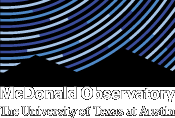University of Texas at Austin Astronomer Sally Dodson-Robinson Receives Prestigious Career Grant from National Science Foundation
AUSTIN, Texas — University of Texas at Austin Assistant Professor Sally Dodson-Robinson has received a Faculty Early Career Development award of $363,000 from the National Science Foundation (NSF).
These prestigious NSF awards, called CAREER grants, recognize promising young faculty members and support their research and education missions with five years of funding. Dodson-Robinson has so far been awarded $363,000 in support of her research program called "Giant Planets in Dusty Disks."

